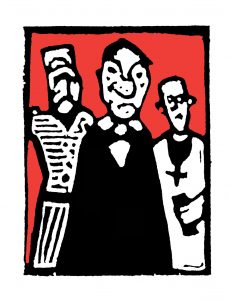by Professor Peter Stoneley, Head of Department, English Literature, University of Reading
A poem about a man who murdered his wife isn’t an obvious choice for Valentine’s Day, but Oscar Wilde made it clear that his The Ballad of Reading Gaol was, in fact, about love:
Yet each man kills the thing he loves,
By each let this be heard,
Some do it with a bitter look,
Some with a flattering word.
Written after his two years of imprisonment with hard labour from 1895 to 1897, and first published on February 13th 1898, Wilde’s poem focused on an execution by hanging that was carried out in Reading Prison during his own incarceration. Charles Thomas Wooldridge was a trooper in the Royal Horse Guards who, out of jealousy, stabbed his wife to death. Wooldridge thought his death sentence was right, and he did not seek clemency. He was hanged on 7 July 1896, and buried in an unmarked grave within the Prison walls.

In the present climate, where attitudes and behaviour towards women are rightfully being challenged, presenting Wooldridge as a hero, or suggesting his actions were a “crime of passion”, seems abhorrent. Wilde, though, draws Wooldridge with sympathy. The trooper seems haunted by his crime, as he looks “with such a wistful eye/Upon that little tent of blue/Which prisoners call the sky”.
Further, Wilde chooses to explore the thought that all people fail their love in one way or another: “each man kills the thing he loves”. The paradox of the poem is that Wooldridge becomes the hero of love because he, out of the intensity of his devotion, commits the greatest crime.
Wilde appears completely out of step with present-day attempts to bring violence against women to an end. Does he not glamorise his hero’s murderous possessiveness? Perhaps Wilde intended for us to see Wooldridge as having a heroic quality precisely because he does not justify his actions. He sees himself as having committed the ultimate crime. And, having killed the woman he loved, he does not seek to escape the ultimate punishment. Wooldridge seems to have asserted a kind of ownership of his wife in killing her. Yet within moments he was appalled by his own act.
Perhaps, precisely because the sexual politics of Wilde’s famous ballad are troubling, now is an apt time to revisit it. But Wilde’s main goal in writing his poem was to bring about reform in the prisons. He felt that the prisons of his day were cruel and unfair, especially regarding imprisonment of children and the mentally disturbed. The poem’s exploration of love and injustice is fitting given Wilde was imprisoned for his own passions, having been sent to prison for “acts of gross indecency with another male person”.
While the actions of Wilde’s anti-hero in his ballad may be too unpalatable to dwell on this Valentine’s Day, reflecting on Wilde’s own plight nevertheless shows us that crime and persecution are so often entangled with love.
Exhibition a chance to revisit poem
To mark the 120th anniversary of the poem’s first publication, the University of Reading has partnered with the Berkshire Record Office and the collector and Wilde expert, Michael Seeney, to hold the first exhibition of illustrated editions. Many different artists have, over the years, done illustrations for new editions of the poem, so the poem exists in many different formats, and with many different illustrations. The exhibition shows these.

The free exhibition – “Colours More Than Sentences” – opens on Wednesday 15 March at the Berkshire Record Office, 9 Coley Avenue, Reading RG1 6AF. It will feature more than 30 different editions from places around the globe, including Argentina, France, Germany, Italy, Hong Kong, Netherlands, Spain, the United Kingdom, and the United States.
The formats range from the tiny black-and-white editions to enormous colour versions. Also on display will be original drawings by “Whitechapel Girl” Clare Winsten (1892-1984), whose husband was imprisoned as a conscientious objector during the First World War.
“Colours More Than Sentences” draws heavily on the collection and the knowledge of Wilde expert, Michael Seeney. A former civil servant, Michael has gradually assembled an amazing collection of Wilde artefacts, from letters and photographs to a rare plaster-cast of the playwright’s hand. His collecting began when, as a small child, he was given a “talking book” of The Happy Prince. He now has more than 2,000 items. His most recent book, on Oscar Wilde’s “forgotten friend,” More Adey, was published last year.
